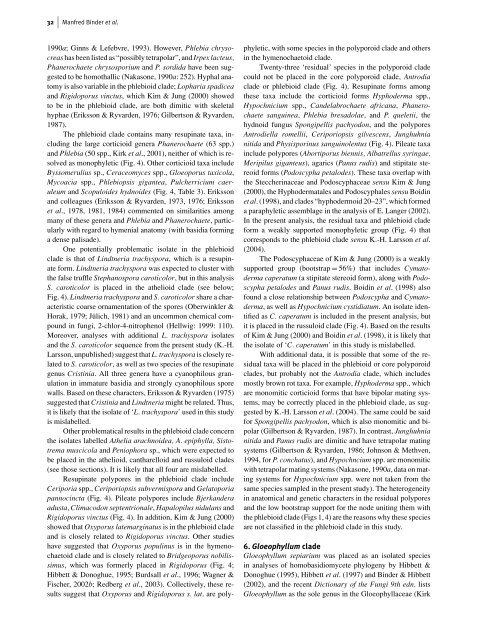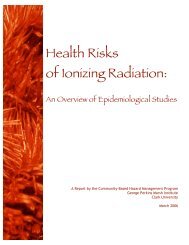The phylogenetic distribution of resupinate forms ... - Clark University
The phylogenetic distribution of resupinate forms ... - Clark University
The phylogenetic distribution of resupinate forms ... - Clark University
Create successful ePaper yourself
Turn your PDF publications into a flip-book with our unique Google optimized e-Paper software.
32 Manfred Binder et al.<br />
1990a; Ginns & Lefebvre, 1993). However, Phlebia chrysocreas<br />
has been listed as “possibly tetrapolar”, and Irpex lacteus,<br />
Phanerochaete chrysosporium and P. sordida have been suggested<br />
to be homothallic (Nakasone, 1990a: 252). Hyphal anatomy<br />
is also variable in the phlebioid clade; Lopharia spadicea<br />
and Rigidoporus vinctus, which Kim & Jung (2000) showed<br />
to be in the phlebioid clade, are both dimitic with skeletal<br />
hyphae (Eriksson & Ryvarden, 1976; Gilbertson & Ryvarden,<br />
1987).<br />
<strong>The</strong> phlebioid clade contains many <strong>resupinate</strong> taxa, including<br />
the large corticioid genera Phanerochaete (63 spp.)<br />
and Phlebia (50 spp., Kirk et al., 2001), neither <strong>of</strong> which is resolved<br />
as monophyletic (Fig. 4). Other corticioid taxa include<br />
Byssomerulius sp., Ceraceomyces spp., Gloeoporus taxicola,<br />
Mycoacia spp., Phlebiopsis gigantea, Pulcherricium caeruleum<br />
and Scopuloides hydnoides (Fig. 4, Table 3). Eriksson<br />
and colleagues (Eriksson & Ryvarden, 1973, 1976; Eriksson<br />
et al., 1978, 1981, 1984) commented on similarities among<br />
many <strong>of</strong> these genera and Phlebia and Phanerochaete, particularly<br />
with regard to hymenial anatomy (with basidia forming<br />
a dense palisade).<br />
One potentially problematic isolate in the phlebioid<br />
clade is that <strong>of</strong> Lindtneria trachyspora, which is a <strong>resupinate</strong><br />
form. Lindtneria trachyspora was expected to cluster with<br />
the false truffle Stephanospora caroticolor, but in this analysis<br />
S. caroticolor is placed in the athelioid clade (see below;<br />
Fig. 4). Lindtneria trachyspora and S. caroticolor share a characteristic<br />
coarse ornamentation <strong>of</strong> the spores (Oberwinkler &<br />
Horak, 1979; Jülich, 1981) and an uncommon chemical compound<br />
in fungi, 2-chlor-4-nitrophenol (Hellwig: 1999: 110).<br />
Moreover, analyses with additional L. trachyspora isolates<br />
and the S. caroticolor sequence from the present study (K.-H.<br />
Larsson, unpublished) suggest that L. trachyspora is closely related<br />
to S. caroticolor, as well as two species <strong>of</strong> the <strong>resupinate</strong><br />
genus Cristinia. All three genera have a cyanophilous granulation<br />
in immature basidia and strongly cyanophilous spore<br />
walls. Based on these characters, Eriksson & Ryvarden (1975)<br />
suggested that Cristinia and Lindtneria might be related. Thus,<br />
it is likely that the isolate <strong>of</strong> ‘L. trachyspora’ used in this study<br />
is mislabelled.<br />
Other problematical results in the phlebioid clade concern<br />
the isolates labelled Athelia arachnoidea, A. epiphylla, Sistotrema<br />
muscicola and Peniophora sp., which were expected to<br />
be placed in the athelioid, cantharelloid and russuloid clades<br />
(see those sections). It is likely that all four are mislabelled.<br />
Resupinate polypores in the phlebioid clade include<br />
Ceriporia spp., Ceriporiopsis subvermispora and Gelatoporia<br />
pannocincta (Fig. 4). Pileate polypores include Bjerkandera<br />
adusta, Climacodon septentrionale, Hapalopilus nidulans and<br />
Rigidoporus vinctus (Fig. 4). In addition, Kim & Jung (2000)<br />
showed that Oxyporus latemarginatus is in the phlebioid clade<br />
and is closely related to Rigidoporus vinctus. Other studies<br />
have suggested that Oxyporus populinus is in the hymenochaetoid<br />
clade and is closely related to Bridgeoporus nobilissimus,<br />
which was formerly placed in Rigidoporus (Fig. 4;<br />
Hibbett & Donoghue, 1995; Burdsall et al., 1996; Wagner &<br />
Fischer, 2002b; Redberg et al., 2003). Collectively, these results<br />
suggest that Oxyporus and Rigidoporus s. lat. are poly-<br />
phyletic, with some species in the polyporoid clade and others<br />
in the hymenochaetoid clade.<br />
Twenty-three ‘residual’ species in the polyporoid clade<br />
could not be placed in the core polyporoid clade, Antrodia<br />
clade or phlebioid clade (Fig. 4). Resupinate <strong>forms</strong> among<br />
these taxa include the corticioid <strong>forms</strong> Hyphoderma spp.,<br />
Hypochnicium spp., Candelabrochaete africana, Phanerochaete<br />
sanguinea, Phlebia bresadolae, andP. queletii, the<br />
hydnoid fungus Spongipellis pachyodon, and the polypores<br />
Antrodiella romellii, Ceriporiopsis gilvescens, Junghuhnia<br />
nitida and Physisporinus sanguinolentus (Fig. 4). Pileate taxa<br />
include polypores (Abortiporus biennis, Albatrellus syringae,<br />
Meripilus giganteus), agarics (Panus rudis) and stipitate stereoid<br />
<strong>forms</strong> (Podoscypha petalodes). <strong>The</strong>se taxa overlap with<br />
the Steccherinaceae and Podoscyphaceae sensu Kim & Jung<br />
(2000), the Hyphodermatales and Podoscyphales sensu Boidin<br />
et al. (1998), and clades “hyphodermoid 20–23”, which formed<br />
a paraphyletic assemblage in the analysis <strong>of</strong> E. Langer (2002).<br />
In the present analysis, the residual taxa and phlebioid clade<br />
form a weakly supported monophyletic group (Fig. 4) that<br />
corresponds to the phlebioid clade sensu K.-H. Larsson et al.<br />
(2004).<br />
<strong>The</strong> Podoscyphaceae <strong>of</strong> Kim & Jung (2000) is a weakly<br />
supported group (bootstrap = 56%) that includes Cymatoderma<br />
caperatum (a stipitate stereoid form), along with Podoscypha<br />
petalodes and Panus rudis. Boidin et al. (1998) also<br />
found a close relationship between Podoscypha and Cymatoderma,aswellasHypochnicium<br />
cystidiatum. An isolate identified<br />
as C. caperatum is included in the present analysis, but<br />
it is placed in the russuloid clade (Fig. 4). Based on the results<br />
<strong>of</strong> Kim & Jung (2000) and Boidin et al. (1998), it is likely that<br />
the isolate <strong>of</strong> ‘C. caperatum’ in this study is mislabelled.<br />
With additional data, it is possible that some <strong>of</strong> the residual<br />
taxa will be placed in the phlebioid or core polyporoid<br />
clades, but probably not the Antrodia clade, which includes<br />
mostly brown rot taxa. For example, Hyphoderma spp., which<br />
are monomitic corticioid <strong>forms</strong> that have bipolar mating systems,<br />
may be correctly placed in the phlebioid clade, as suggested<br />
by K.-H. Larsson et al. (2004). <strong>The</strong> same could be said<br />
for Spongipellis pachyodon, which is also monomitic and bipolar<br />
(Gilbertson & Ryvarden, 1987). In contrast, Junghuhnia<br />
nitida and Panus rudis are dimitic and have tetrapolar mating<br />
systems (Gilbertson & Ryvarden, 1986; Johnson & Methven,<br />
1994, for P. conchatus), and Hypochncium spp. are monomitic<br />
with tetrapolar mating systems (Nakasone, 1990a,dataonmating<br />
systems for Hypochnicium spp. were not taken from the<br />
same species sampled in the present study). <strong>The</strong> heterogeneity<br />
in anatomical and genetic characters in the residual polypores<br />
and the low bootstrap support for the node uniting them with<br />
the phlebioid clade (Figs 1, 4) are the reasons why these species<br />
are not classified in the phlebioid clade in this study.<br />
6. Gloeophyllum clade<br />
Gloeophyllum sepiarium was placed as an isolated species<br />
in analyses <strong>of</strong> homobasidiomycete phylogeny by Hibbett &<br />
Donoghue (1995), Hibbett et al. (1997) and Binder & Hibbett<br />
(2002), and the recent Dictionary <strong>of</strong> the Fungi 9th edn. lists<br />
Gloeophyllum as the sole genus in the Gloeophyllaceae (Kirk
















